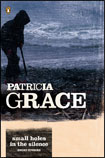
SMALL HOLES IN THE SILENCE: Short Stories, Patricia Grace, Penguin, Auckland, New Zealand, 2006, 214 pages, paperback, NZ$35. ISBN 0-14-302099-4
A little dangle on a fine thread
There are only five words that aren’t true in this collection. They are “You won’t like this story.” They open a bleak tale called Stranger Danger, which may not be cherished but will be admired for its economy of words, its sympathy for unlikeable people and its unstoppable narrative power. Patricia Grace is the Ancient Mariner of our storytellers; once one of her opening sentences has gripped readers, they have no choice but to stay to the end.
There are only five words that aren’t true in this collection. They are “You won’t like this story.” They open a bleak tale called Stranger Danger, which may not be cherished but will be admired for its economy of words, its sympathy for unlikeable people and its unstoppable narrative power. Patricia Grace is the Ancient Mariner of our storytellers; once one of her opening sentences has gripped readers, they have no choice but to stay to the end.
“Mark died last week. So did Gregory Peck.” After that attention-grabbing beginning, there is no turning back, even when the narrator confesses a few pages later that it was just opportunistic name-dropping, “a little dangle on a fine thread seeking attention on Mark’s behalf.” Nobody begrudges Patricia Grace her success with her award-winning novels but her short stories were our first contact with her tale-telling and this volume is full of those little dangles on fine threads that we recall from Waiariki and The Dream Sleepers
Where young and adolescent characters were once the focus of Grace’s stories, many of them are now narrated by an older woman, seated on a roadside bench watching people pass by and missing nothing. These are stories from what one character calls the “here-and-now” and “back then”. The settings range more widely than in the earlier collections, encompassing several New Zealands - rural and urban – as well as Italy and Russia but the characters, as always, remain sharply etched in the memory.
The use of mythology in several of the stories is a new aspect. Tawhaki is here complete with his lightning-flashing armpits. In Moon Story Rona is still snatched away from her home but she becomes reconciled to her exile on the moon. “Her new home was roomy and comfortable and she became aware that anxiety and stress were unknown in this new place. She found she could relax there.”
As in so many of these stories, an unexpected and unpromising encounter becomes a love story. The best of them, appropriately titled Love Story, has a Maori elder taking a polytech class to a small urban meeting house. The students are lost souls “with their tats and studs and piercings, their beads and rings and chains, their hair dags and head shaves, their busted jeans and shoes” but one of them finds redemption when he is enthralled by a carved poutokamanawa statue, The Beautiful One.
Grace has an excellent ear for speech patterns and never a word is wasted. In the bitter Manners Street Blues the word blue carries at least four meanings: a sad song, a fight, a mistake and the police. The characters’ names are also evocative: Elvis (born when Presley’s gold Cadillac was on display), Morehu (survivor), Seoul (whose father served in Korea), Crooked Eben and Raycharles. These stories are full of riches: the personal stresses behind a tangi, a young woman’s yearning for motherhood, and an old lady’s awareness of her mortality. There is always the feeling that we know some of these people.
At the same time Patricia Grace has a splendid sense of humour. In Wendel, a fleeing thief, “a self-taught invisibilist” takes the place of the koruru above the gable of a new meeting house. The most enjoyable part is that nobody mentions his hiding place to the searching police, not because they want to protect him but because they’re rushing to be ready for the official opening ceremonies. In Pa Wars the pun in the title is intentional. At a tribal sports tournament Petina, a liberated young woman is coolly evaluating possible sperm donors, but discovers that romance can strike unexpectedly, especially when a tiny pair of gumboots becomes involved.
Small Holes in the Silence is an excellent collection, lively and readable, further evidence that Patricia Grace continues to working the top of her form.
Trevor Agnew
First published in The Press, Christchurch, New Zealand on November 28th 2006.

No comments:
Post a Comment